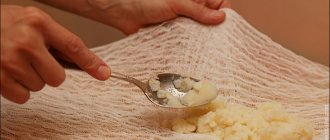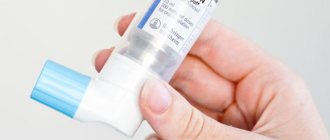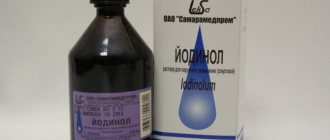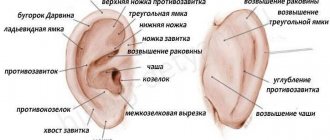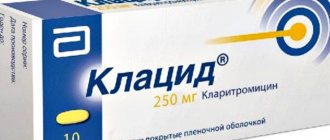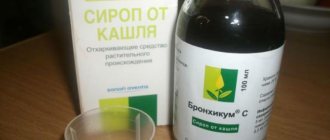Causes of ear pain
Most often it occurs due to infection in the ear and the development of otitis media. It seems that the runny nose and cold no longer bother me, but my ears still hurt. In such cases, otitis media can be caused by an allergic reaction to medications, general hypothermia, or decreased functioning of the immune system.
To get rid of otitis, experts recommend a set of measures: the use of ear drops and antibiotics, warming procedures. But in most cases, people prefer such a folk remedy as an alcohol compress on the ear.
How to apply a compress for the ear at home
Before applying the compress, you should thoroughly clean the ear. It is better to use a cotton swab for cleaning. No need to go inside your ear. If you have sensitive skin, the area around the ear should be lubricated with a rich baby cream. Further according to the algorithm:
- Fold the gauze into 5-7 layers. The resulting square should be slightly larger in size than the sore ear.
- Make a V-shaped or square cut in the gauze to fit your ear.
- Soak the gauze in the warming solution, wring it out and place it on the ear. The gauze should fit tightly to the skin behind the ear, the ear itself should be on the surface.
- Place a piece of polyethylene over the gauze. You should also make a hole in it in the shape of your ear.
- The third layer is cotton wool. It should completely cover the ear and the area around it.
- Secure the compress with gauze. You can wear a hat or woolen scarf on top.
In some people, otitis media develops literally after the slightest hypothermia: swimming in cold water, walking in windy weather, being in a draft, etc. If purulent processes have not yet begun in the ear, the disease can be overcome exclusively by local methods. The simplest and most effective method to relieve inflammation is to apply a warm compress to the ear at home. It will quickly eliminate pain, and all the necessary ingredients and preparations - bandages, cotton wool, alcohol - can usually be found at home.
If you notice symptoms of otitis in yourself or your child, consult a qualified doctor. In case of self-medication or untimely treatment, serious health problems can arise.
An otolaryngologist who will prescribe physiotherapeutic procedures and medication during your appointment. In addition, he will advise you to apply compresses to the sore ear.
Compresses at home:
- Herbal compress. Prepare a special decoction. To do this, mix three tablespoons of dried herbs basil, sweet clover and chamomile. Pour one glass of boiling water and leave for thirty minutes, and then strain well. Fold the gauze into 7 layers and soak in the prepared herbal decoction. Squeeze lightly. Place it on your ear and cover it with cellophane. Secure with a bandage or scarf.
- Compress according to Tsitovich with boric acid. It perfectly relieves inflammation and relieves pain. Gauze or bandage is soaked in glycerin and boric acid (its three percent solution). Next, a tampon is made and inserted into the ear. The compress is removed after three hours.
In addition, there are two more types of compresses that are much more common: oil and alcohol. To make an oil compress, camphor or vegetable oil is used. It retains heat longer, but is not as convenient as an alcohol compress, due to the fact that the oil can leak onto clothing or stain everything around it. It is for this reason that preference is usually given to alcohol compresses.
Fold the cheesecloth and place them into one large napkin. Cut a circle in the middle of the napkin with a diameter no smaller than your ear. It needs to fit in it. A gauze pad is usually soaked in camphor or vegetable oil diluted with alcohol or vodka. If you decide to make an alcohol compress, use alcohol for impregnation.
After the gauze is well saturated with alcohol or oil, you should squeeze it out well so that the drops cannot get on your clothes or hair. The prepared compress is applied to the ear, placing it in a cut previously made in a gauze napkin. Apply a layer of cotton wool and wrap the sore ear with a bandage, scarf or scarf.
More information on how to apply an alcohol compress to children can be found in the video.
It should be remembered that at elevated body temperatures, applying a compress is not recommended due to adverse consequences. In addition, you should definitely consult with your doctor whether this type of treatment can be used.
To prevent skin burns from the compress, lubricate the areas near the sore ear with any fatty cream. The compress should adhere well to the surface of the skin.
Compressing the ear at home will not require much effort from you. To make it, you will need:
- Gauze or napkins based on it
- Vodka or alcohol
- Scissors
- Camphor oil
- Scarf or cap
Contraindications
- Purulent otitis. With this disease, pus under the influence of heat can spill into the ear. Compresses are allowed, but without a warming effect.
- Mastoiditis, labyrinthitis (complications of otitis media).
How to make an alcohol compress on the ear?
To prepare, you will need to take gauze, a bow, alcohol or vodka. First, a hole is cut out in a gauze napkin for the auditory organ. Next, it is soaked in alcohol and wrung out well. It is important to remember that the skin of the ear is very sensitive and delicate, so the compress is not applied to it, but to the area around the ear. The gauze pad should fit tightly to the skin. A layer of cotton wool is applied on top, the area is bandaged and wrapped in warm cloth.
For one compress you will need about 60 ml of alcohol, which must be mixed with clean water in a 1:1 ratio.
Before applying an alcohol compress to the ear, it is important to make sure that there is no elevated body temperature. Also, the skin on the face and neck should not contain ulcers or inflammation.
At first glance, such treatment is absolutely harmless, but still consultation with a specialist should be mandatory.
Vodka in the ear for otitis media
During the cool season, children and adults often get colds. Most often, the nasopharynx is the first to suffer, and ear diseases come second.
In this case, it is important to start treatment promptly and prevent ear infections from spreading. To do this, you need to consult a doctor for advice. Many experts, along with drug treatment, recommend lotions and instillations of vodka. However, is it possible to drip vodka into your ear? We will analyze the answer to this question in this material.
About the occurrence of infections
Often, at the very beginning of inflammation, experts recommend alternative medicine methods. They are known to be more gentle and do not cause harm. One such method could be putting vodka in the ear.
In folk medicine, alcohol is actively used in the treatment of flu and colds . In addition, vodka tinctures effectively help with catarrhal changes in the mucous membrane of the nasopharynx and bronchi.
Since ancient times, vodka tincture has been rubbed onto the back and chest area to warm and remove phlegm.
In addition, vodka compresses are used to improve blood circulation. It is best to apply these compresses at night for diseases of bronchitis and other pneumonia.
In addition, alcohol helps with headaches, extreme fatigue and high blood pressure. Alcohol helps dilate blood vessels and improve blood circulation.
Some experts believe that vodka has an effective effect on ear diseases.
Inflammation in the outer, middle or inner ear causes extremely unpleasant moments. Painful sensations can incapacitate a person for a long time. Typically, the cause of inflammation in the ear is a cold. In addition, the following reasons are noted:
- Viral diseases.
- Traumatization of the ear.
- Lack of hygiene.
- Long-term use of antibiotics.
- Seasonal allergies.
- Staying outside for a long time during the cold season.
- Drafts.
In case of illness, you must consult a doctor for examination, identifying the root cause and prescribing an individual course of treatment.
Alcohol is known to have antiseptic properties.
Is it possible to put vodka in your ear?
The use of vodka is allowed for many diseases. But methods and recipes are selected depending on the cause of inflammation.
However, you should know that in case of purulent discharge from the ears and perforation of the eardrum, the use of alcohol compresses is prohibited. So, you can cause yourself a severe burn and make the situation worse.
Alcohol effectively helps with diseases such as:
- Inflammation in the middle ear.
- With senile hearing loss.
- Damage to the outer ear.
- The appearance of ulcers on the outer ear.
- Colds.
- Flu.
- Some types of otitis.
- Severe pain in the ear.
- Noise and crackling in the ear.
Before using vodka in the form of drops or tinctures, you should consult your doctor.
Remember that the use of vodka internally for colds or viral diseases is prohibited . Vodka tends to increase the load on the cardiovascular system. Thus, at a body temperature above 37 degrees Celsius, alcoholic tincture can have a detrimental effect on overall health.
It is important to understand that if the body temperature reaches more than 39 degrees Celsius, traditional medicine is powerless. It is urgent to call an ambulance, as serious infectious processes are taking place in the body.
Treatment methods
After you have consulted with a qualified doctor, you can turn to traditional medicine, namely the use of vodka as tinctures or drops.
It is known that any alcohol-containing tinctures effectively relieve inflammation and pain in the ear.
In addition, vodka can be used as heat therapy. It retains heat for five hours.
To treat children, vodka must be diluted with water. Otherwise, it may cause serious burns when used.
For therapeutic purposes, vodka can be used in two forms:
In the first case, you will need gauze, a cotton pad, a bandage and polyethylene . Using a bandage, you need to make a bandage on the sore ear, after placing cotton wool soaked in vodka on it.
Squeeze thoroughly before placing the cotton pad or gauze on the affected area. Then you need to cover the ear with plastic and wrap the ear with a bandage. The bandage should be tight and keep the compress tightly on the ear.
In case of thin skin around the ear, you should dilute vodka with water. This way it won't burn the skin.
Keep the compress for two hours . Then remove the bandage and rinse your ear in warm water. After this, wipe your skin dry.
Remember that after compresses you cannot go outside for three hours. Therefore, it is recommended to carry out the described operation before going to bed.
This method reduces pain and has a beneficial effect on the affected cells . However, this compress is prohibited at elevated temperatures, as well as with purulent otitis or other discharge from the ears.
To disinfect the ear and alleviate the general condition of the patient, lovers of alternative medicine use the injection of vodka drops into the ear.
Remember that you need to insert vodka into your ear very carefully.
Due to its properties when perforating the tympanic area, alcohol can have a detrimental effect on health. There have been cases of hearing loss for several years.
Source: https://mens-recipes.ru/vodku-v-uho-pri-otite/
Treatment of ear pain in children
If a child has ear pain, especially at a very young age, it may be due to the structure of the inner ear. At such years, the ear canal is still too short, and also wide. This leads to otitis from the smallest runny nose, so ordinary snot cannot be treated irresponsibly. It is better to cure it than to allow the child to suffer from ear pain in the future.
If the baby's body temperature is less than 37%, you can apply an alcohol compress to the baby's ear. It is believed that it is best to use forty proof vodka. Naturally, the necessary components of the compress are cotton wool, gauze, a bandage, a piece of cellophane and something for insulation.
Before making a vodka compress for your child’s ear, be sure to clean the outer part of the ear. Doctors never recommend doing this with a cotton swab, since this can push the accumulated wax deeper into the ear. The best remedy is a cotton swab.
Vodka is preheated to 37 degrees. Then, wrapped in 6 layers, gauze with a hole cut out for a small ear is soaked in it. You do not need to squeeze the gauze very hard, since vodka tends to evaporate quickly, but not lightly, so that the liquid does not flow down the child’s neck. This warming layer is covered with polyethylene or cellophane so that the compress on the ear with vodka does not get cold, and the cotton wool placed on top does not get wet. In general, the layer of cotton wool must be quite large for the heating to be effective.
How long to keep an alcohol compress on the ear?
This design is fixed with a bandage and wrapped, for example, with a scarf or a children's hat. How long to keep an alcohol compress on a child’s ear? He must endure this procedure for about 4 hours, and it should begin between two and four o'clock in the afternoon, since this is considered to be the most favorable period for manipulation of the ears.
After finishing, the skin is wiped with a damp cloth and lubricated with cream. If you don’t have vodka on hand, you can make a compress in the child’s ear with alcohol. Ordinary medical alcohol, which will have to be diluted with water, or boric alcohol will also work. The main thing to remember is that undiluted alcohol can cause burns on delicate baby skin.
Use of boric alcohol
Home treatments with this substance are carried out by instilling several drops of boric alcohol into the ears. There are some rules to do everything correctly and efficiently.
First, the ear is treated with a few drops of hydrogen peroxide. After 10 minutes, you need to turn over and do the same with the other ear. Next, you can drip boric alcohol using a pipette. If you don't have a pipette, you can fold a small piece of gauze, soak it in alcohol, and insert it into your ear. Considering the many years of experience of people struggling with ear pain, it is best to alternate the procedure of instillation and insertion of gauze, which can be safely called an ear compress made of boric alcohol. It is recommended to repeat the manipulation three times a day.
What is needed for the procedure?
Before making a compress on the ear, you need to prepare the materials:
- For an oil compress - camphor oil, heated in a steam bath. For alcohol - vodka or alcohol diluted 1:1 with water, boric acid solution.
- Gauze, polyethylene, cotton wool and bandage.
Before applying the compress, apply baby cream to the skin around the ear. This will help avoid irritation from alcohol in the area where the bandage is placed.
Procedure using alcohol
An alcohol compress on the ear is the most popular home remedy for otitis media. Step-by-step instructions for applying a bandage:
- Dilute alcohol 1:1 with water to achieve the desired concentration and warm up slightly.
- Fold the gauze into 6-8 layers and make a hole.
- Immerse it in liquid and apply it to the parotid area.
- Cover the top with film or compress paper.
- Cover with a piece of cotton wool.
- Secure with a bandage or scarf.
If the bandage cools down too quickly, it means that it is applied incorrectly. In this case, it needs to be redone. For an adult, it is enough to keep the bandage on for 1-2 hours, and for a child, you can do the procedure twice a day: in the morning and before bed. After applying the compress to the child’s ear, you can secure it with a hat.
Compress with dimexide
Dimexide has anti-inflammatory, antiseptic and warming effects. It can eliminate pain of moderate intensity if the procedure is carried out correctly. To do this, you need to moisten gauze in the solution, squeeze it thoroughly and apply it to the parotid area. Cover with film and insulate with a layer of cotton wool, secure with a bandage. This bandage should be applied once a day. Do not exceed the time (20 minutes), otherwise skin burns may occur.
Folk recipes
Recipes for folk remedies can be useful: herbal decoctions, honey, propolis tincture. They have regenerating and anti-inflammatory properties, eliminate unpleasant odors, and heal. For ear pain during catarrhal otitis, you need to roll up a cotton ball, moisten it in propolis tincture, apply a warming compress on top, according to the usual algorithm, and leave for 12 hours. During pregnancy, you need to dilute the propolis tincture with warm water (1:1) and add an oil base. To prepare a solution from herbs, mix mint juice, fireweed and honey in equal parts, add hot water (1:8). Then moisten the napkin and apply it to the parotid area in the usual way. Exposure time – 4 hours. Such procedures cannot be performed if there is a history of allergic reactions to phytocomponents.
Dry compress
Dry dressings are designed to limit environmental exposure to the affected area, as well as absorb exudate from the auricle, which breaks through the eardrum during illness. They do not bring in heat from the outside, but simply help preserve what is available. These bandages can be placed either around the ear or on top. A dry cotton-gauze pad 2-3 cm thick is placed over the ear and secured with a bandage, and if necessary, put on a hat.
Algorithm for applying a compress
To obtain an analgesic and anti-inflammatory effect, it is important to adhere to the technique of applying wet and dry dressings at home.
Before the procedure, you must wash and dry your hands, prepare equipment and solutions. To avoid burns, inspect the skin before applying a bandage. To properly apply layers of compress, you need to choose the most comfortable position.
Children are placed on their side, while adults apply the compress in a sitting position. For better contact of medications with the parotid area, an incision is made in the moist and insulating layers. Fix the layers with a bandage or scarf.
Inner layer
If the compress is wet, then folding 6-8 layers of torn bandage or gauze, shaped to the required dimensions, is sufficient.
If the compress is dry, then to the existing layers of bandage, one or two layers of cotton wool are added between them, evenly located within the contour of this layer of the bandage.
A warming compress involves the use of dry heat (the inner layer is heated with an iron before applying to the body, making sure that it is not too hot) or a pre-heated solution of a medicinal substance.
Technique for applying a warm compress Fig. 1 - required material, Fig. 2 - general view of the compress
In the absence of gauze and bandage, the inner layer can be formed with a clean piece of any easily saturated natural fabric, which is recommended to be pre-ironed with a hot iron for disinfection.
Middle layer
Its main function with dry compresses is to maintain a constant temperature near the skin area, regardless of changes in the environment during the cold or hot season, and if necessary, go outside.
In the case of applying a wet compress, the middle layer has an insulating function, preventing the liquid from soaking the entire dressing and clothing items, thereby reducing the concentration of the medicinal substance and its effectiveness.
Waxed or kraft paper is most often used to create the middle layer. When applying a wet compress, cellophane (polyethylene) can be used instead of paper.
Outer layer
Its function is additional insulation. Cotton wool is used for this.
In order for the effect of the compress to be maximum, it is important to remember that each subsequent layer should be 2-3 cm wider than the previous one.
Dry compress
This type of ear compress is acceptable as a warming agent only at the initial stage of otitis media.
It is contraindicated to use it in case of severe inflammation. It can be filled with heated table salt, which is preheated to 60 degrees. Hot salt is placed in a linen bag, which is carefully wrapped in a towel or piece of plain cloth. A multi-layer compress is applied to the ear, holding until the salt cools completely. If dry heat is needed at the stage of removing purulent masses, then a compress is created simply from several layers of cotton wool and a sterile bandage.
Compress for otitis: how to relieve inflammation in the disease
Treatment of otitis media is carried out with anti-inflammatory and antibacterial medications. Also, during the inflammatory process occurring in the ear cavity, physiotherapy is useful, among which heating is considered effective. A warm compress for otitis media has the same effect on an inflamed ear, eliminating pain, relieving swelling and reducing inflammation.
Types of compresses
For otitis, a compress on the ear is a common procedure, widely used in home treatment of the disease. It can be of two types - dry and wet. There are also additional types of such treatment - lotions and poultices. In addition, compresses are distinguished depending on their base; they can be alcohol or oil. Alcohol compress is also popularly known as vodka compress. It is difficult to say which type of procedure is better, because it all depends on the form of the disease and its neglect. If you need longer heat retention on the affected area of the body, then it is better to choose oil compresses.
Another type of warming procedure for the ears is turundas. In the daytime, cotton wool should be put on a medicinal product - anti-inflammatory or antibacterial; at night it is better to soak them in alcohol and keep them like that until the morning.
Rules for the procedure
To make an alcohol compress for otitis, you need to prepare a clean cotton cloth, moisten it in warm alcohol and apply it to the sore ear. You must first make a hole for the ear; alcohol should not get into the auricle itself.
When treating a disease in children, you cannot use vodka or alcohol in its pure form; they must be diluted halfway with water.
The wet fabric is covered with plastic film on top, then a piece of cotton wool or flannel should be applied for a warming effect. All layers of the compress must be secured with a bandage and removed after 3–4 hours.
The basis of the oil compress is vegetable or camphor oil. It holds the body for a long time, improves blood circulation, eliminates the main symptoms and speeds up the healing process. Lavender oil and lemon wormwood relieve pain well. They are also endowed with powerful bactericidal and anti-inflammatory effects.
When should the procedure not be performed?
Not in all cases, compresses are indicated for use in adults and children with otitis media. Sometimes their use can harm the condition of a sick person. It is prohibited to use this method of treatment under the following conditions:
- temperature above 37.5 degrees;
- there are lesions on the skin around the ear;
- the course of purulent-inflammatory diseases in the ear cavity.
Based on the fact that a child’s skin is very delicate and sensitive, it is recommended to use semi-alcohol compresses when treating otitis media in children. They received this name due to the fact that vodka or alcohol is half diluted with water. If your skin is hypersensitive, you should dilute the vodka by more than half with water. This approach will avoid burning the baby’s delicate skin.
Folk remedies
Some people prefer treating otitis media with traditional medicine. Despite doctors’ beliefs that such treatment is not safe, many cannot give up folk remedies. For otitis, make a compress with beets. To prepare the medicine, beets need to be cut and boiled in honey. Apply as a compress to the sore ear.
If you have a blown ear and experience unpleasant sensations in the form of shooting and throbbing pain, supporters of traditional medicine may advise you to use cumin. To prepare the medicine you will need a spoon of cumin, a spoon of juniper fruits, 5 tbsp. l. rye flour. The fruits of caraway and juniper should be crushed into powder, flour should be added, and the dough should be kneaded. A flat cake is baked from the prepared dough, then the crust must be removed from it, soaked in alcohol and placed around the sore ear while warm. When the crust becomes soft, you need to remove it and put a turunda with almond oil in your ear.
To prevent complications of otitis media, it is important that treatment is carried out under the supervision of a specialist. NasmorkuNet.ru>. NasmorkuNet.ru>
NasmorkuNet.ru>
What types of ear compresses are there?
In medical practice, there are several types of ear compresses:
- Alcohol. Vodka compress for otitis has a warming effect and has an antiseptic effect. Similar treatment is used to prevent otitis media. If purulent contents are observed in the ear canal, these manipulations are strictly prohibited. When heated, bacterial microflora begins to spread throughout the lymphatic and circulatory system of the human body;
- Oily. They are used as an antiseptic. Oil particles not only destroy harmful bacteria, but also moisturize the skin.
Before applying a compress for otitis media on a problem area, you must undergo an allergy test. To do this, a small amount of the active substance is applied to the back of the elbow. If redness or severe itching appears, then applying a bandage with the active substance to the ear is prohibited.
Alcohol compress
A type of wet compress is vodka or alcohol. Thanks to prolonged heating, pain is relieved, the source of inflammation is disinfected and resolved. As a result, recovery is faster and without stagnation. This method of warming the ear is more convenient, since the liquid does not spread and does not leave stains. However, the fabric cools quickly and must be changed frequently.
Operating principle
The principle of action of traction therapy is based on the reflex effect of heat, which helps relieve pain and restore cellular metabolism. Compressor treatment is one of the effective local agents with pronounced antiphlogistic, local anesthetic and decongestant properties.
A local increase in temperature in the tissues leads to increased production of neutrophils in the body. This group of protein structures is one of the protective cells that prevent the development of pathogenic flora, represented by bacteria, fungi and protozoa. An increase in their concentration in the blood leads to the rapid destruction of pathogens in the body and, accordingly, the elimination of foci of inflammation.
What types of compresses are there?
All compresses are divided into dry and wet. With dry ones, everything is clear: just wrap the cotton wool with a bandage or gauze and secure the compress on the sore ear with a bandage, hat or woolen scarf. A cotton-gauze bandage warms the ears and protects them from contact with the external environment, which is not so little, because any blow of wind only intensifies the pain. To relieve pain, you can make a dry compress for the ear at home from sea or table salt. To do this, heat the salt in a frying pan and pour it into a woven bag. Wrap it in a towel and apply it to the sore ear. Keep the compress until the salt has cooled.
Wet compresses are classified according to the warming agents used:
- Vodka compress. This is the most popular type of ear compress. Lightly warmed vodka is diluted by half with water. For “one adult ear” it takes about 50 ml of vodka. For children, a less concentrated solution is made: vodka is diluted with water in a ratio of 1 to 2 or 1 to 3. The dressing time is no more than 4 hours. Any compress is removed from children's ears after 1.5-2 hours.
- Alcohol compress. Instead of vodka, you can use medical alcohol. Dilute in the same way as in the previous method. The only difference is that the alcohol does not need to be heated. The bandage is kept on the affected ear for a maximum of 4 hours.
- Compresses with boric alcohol. Boric acid is an excellent antiseptic, so it can also be used in the treatment of otitis media. For a compress, mix boric alcohol, vodka and water in equal proportions (about 20 ml of each component). The compress is kept on the sore ear for 2-4 hours.
- Compresses with camphor alcohol. Camphor alcohol has a powerful warming and absorbing effect. Before applying the compress, it is diluted twice with water and heated in a water bath to approximately 40°C. Alcohol can cause irritation, so it is advisable to lubricate the skin around the sore ear with a rich cream. The duration of wearing the compress is 1-2 hours.
- Compresses with camphor oil. Before starting treatment, the oil is heated in a water bath to 40°C. The compress lasts for 2-6 hours. For children, instead of camphor oil, sunflower oil is used.
Before applying an ear compress at home to a child or person suffering from allergies, a skin sensitivity test should be performed. To do this, apply a small amount of compress solution to the inside of the elbow or wrist. If after half an hour you do not find any side effects, the product can be used for treatment. For ear pain, it is recommended to do 1-2 compresses a day; treatment usually lasts 3-7 days.
4Advantages of treatment with compresses
The effectiveness of the vodka dressing is quite high
At the same time, all ingredients are available, which is very important. In addition, the application process is simple and convenient.
A warm compress has a long-lasting effect. Due to the heating of the body area and close contact, the bandage has a healing and preventive effect. The ear bandage can be made not only with alcohol, but also with oil. In this case, the exposure time increases. The most popular substance for compresses is camphor oil. It has a large list of healing properties. Vodka compress is the most preferred type of dressing among the people. This is because alcohol destroys germs. This substance helps fight many diseases through external and internal use. In case of ear inflammation, alcohol has not only an analgesic, but also a therapeutic effect. Dressings using herbal decoctions, mint juice and honey are also quite effective, so you need to choose the one that suits you best. Compress with boric acid. Relieves inflammation and pain. To do this, you need to soak the gauze with boric acid and glycerin. Roll it up and insert it into the ear canal.
How long can you keep the compress on?
How long to keep the bandage depends on the therapeutic purpose, type of procedure and general condition of the patient. Warming compresses have a long duration of action. After the impregnated material has cooled, repeated layers can be applied.
For an adult
Hot dressings are prescribed for rapid warming up. Exposure time is 5-10 minutes. Warming compresses are removed after 7-9 hours. The area where the bandage is applied is wiped with alcohol and covered with a dry, warm cloth. Cold is used for ear injuries and is applied for 2-3 minutes.
To kid
For babies, oil dressings are applied for 6-8 hours, alcohol dressings for 4 hours. After 2 hours, the correctness of the procedure is checked. To do this, place your index finger under the first layer without disturbing the location and tightness of the bandage. The sore spot should be moist. It is better to apply a warming compress in the evening, shortly before bedtime.

